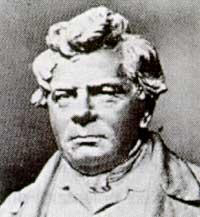OHM, Georg Simon
(1787-1854)
He was born in Erlangen in Bavaria on July 7, 1787. As his father was a mechanic, he was dedicated to science and therefore devoted his children's education to science.
In 1817 he began teaching mathematics and physics at the Jesuit college in Cologne and in 1826 he was appointed professor at the Berlin War School.

His dream was to be a university professor and for this he had to submit research papers. Volta started working on electricity. Being poor he had difficulty acquiring the tooling. Therefore, he himself designed his drivers and he himself had to make the tools with the help of his father.
Ohm decided to apply the electric current in some Fourier discoveries about heat flow. Just as there must be a temperature difference between the two heat transmission points from point A to point B, for the electric current to circulate between two points there must be a difference of electrical potentials between points A and B. In addition, just as heat is easily or hard transmitted depending on the material between the two points, the electric current also flows more easily between two points through certain types of conductors.
Experimenting with electric conductors of different thickness and length, he discovered that the current intensity was inversely proportional to the length of the conductor and directly proportional to the conductor section. Thus, he defined the driver's resistance and discovered that there is a simple relationship between 1827am resistance, potential difference and current intensity. Since then he has been called the law of Ohm and says: "The current intensity along the conductor is directly proportional to the potential difference and inversely proportional to the resistance."
Ohm published this law in his work Die galvanische Kette, mathematisch bearbeitet. It must be clarified that almost half a century before Cavendish, although he had not published it, had discovered the relationship of Ohm's law.
It was a top-notch scientific contribution and I expected Ohm to appoint it for the University. However, some oppose their work and behave as enemies. His criticism forced him to leave his lyceum job.
For six years he lived poor and desperate, but outside Germany they knew and appreciated his work more and more.
1830 B.C. Without news from Becquerel, he pointed to the phenomenon of polarization of batteries. In 1841, the Royal Society of London handed him the medal and the following year he appointed him a member of the association.
In 1833 he was offered a job at the Nuremberg Polytechnic School and worked there. In 1843, the human ear indicated that it could collect sinusoidal waves and separate them into a group. In 1849 he was given the chair at the University of Munich and fulfilled his dream and enjoyed the last five years of his life.
The resistance unit is called ohm, in honor of this German physicist. When between two points of the circuit runs an ampere electric current by a potential difference of a volt, an electrical resistance of an ohm is said to exist.
He died in the same Munich of Ohm Bavaria on 7 July 1854.
Buletina
Bidali zure helbide elektronikoa eta jaso asteroko buletina zure sarrera-ontzian











